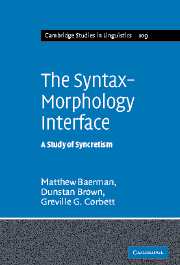Book contents
- Frontmatter
- Contents
- Preface
- List of abbreviations and symbols
- 1 Introduction
- 2 Characteristics of syncretism
- 3 Cross-linguistic typology of features
- 4 Formal representation
- 5 Formal framework and case studies
- 6 Conclusion
- Appendix 1 Case syncretism in the World Atlas of Language Structures sample
- Appendix 2 Person syncretism in the World Atlas of Language Structures sample
- Appendix 3 Syncretism in two-place verbs in the World Atlas of Language Structures corpus
- Appendix 4 DATR fragment for Dhasaanac case study
- Appendix 5 DATR fragment for Dalabon case study
- Appendix 6 DATR fragment for Russian case study
- References
- Author index
- Language index
- Subject index
6 - Conclusion
Published online by Cambridge University Press: 22 September 2009
- Frontmatter
- Contents
- Preface
- List of abbreviations and symbols
- 1 Introduction
- 2 Characteristics of syncretism
- 3 Cross-linguistic typology of features
- 4 Formal representation
- 5 Formal framework and case studies
- 6 Conclusion
- Appendix 1 Case syncretism in the World Atlas of Language Structures sample
- Appendix 2 Person syncretism in the World Atlas of Language Structures sample
- Appendix 3 Syncretism in two-place verbs in the World Atlas of Language Structures corpus
- Appendix 4 DATR fragment for Dhasaanac case study
- Appendix 5 DATR fragment for Dalabon case study
- Appendix 6 DATR fragment for Russian case study
- References
- Author index
- Language index
- Subject index
Summary
Taking stock
It is worth reflecting on how we have reached this point. We began from a logical typology of syncretism. We asked what might theoretically be found, working up from the simplest possibilities (Chapter 2). This approach is feasible because the phenomenon is finite, and particularly worthwhile because syncretism is complex, and the reality does not correspond to many linguists' hunches about it. Given this basis we could move on to the cross-linguistic typology of Chapter 3, where we saw that extending the range of languages beyond those most usually treated for syncretism changes the picture dramatically. Among other things it shows that some of the patterns of syncretism which are familiar from Indo-European are actually somewhat exotic. We relied largely on two samples. First of all, our own sample for the Surrey Syncretisms Database, with thirty languages chosen for genetic and geographic diversity but with the entry condition that they must show instances of syncretism. These were investigated in great detail in preparation for this book. The second sample is that of the World Atlas of Language Structures. This sample of 200 languages, also chosen to avoid genetic and areal bias, provides a useful balance in that it was externally selected; of course, some of the languages provided no helpful data since they lack inflectional morphology. While the breadth of these samples is invaluable in ensuring coverage, so that unusual phenomena do not fall through the net, we were not tied to them.
- Type
- Chapter
- Information
- The Syntax-Morphology InterfaceA Study of Syncretism, pp. 219 - 222Publisher: Cambridge University PressPrint publication year: 2005
- 1
- Cited by



